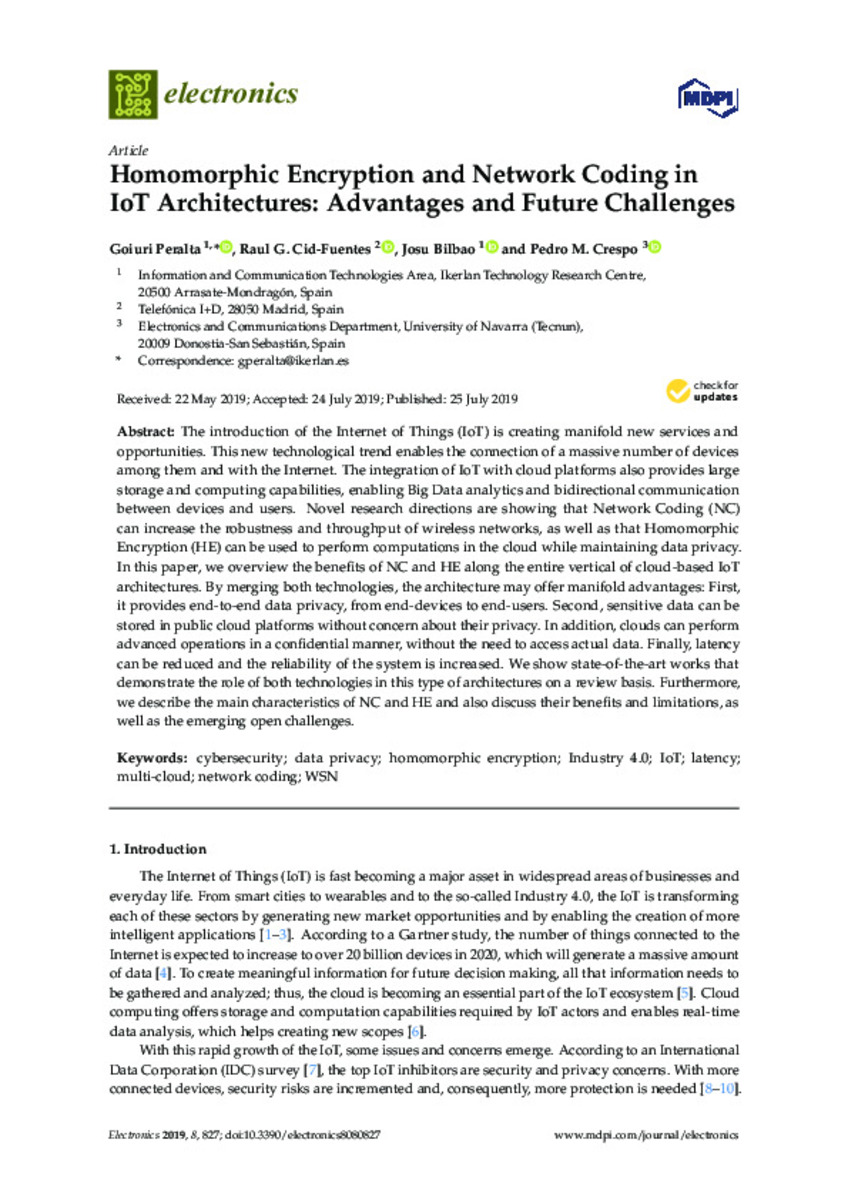Full metadata record
| DC Field | Value | Language |
|---|---|---|
| dc.creator | Peralta, G. (Goiuri) | - |
| dc.creator | Cid-Fuentes, R.G. (Raul G) | - |
| dc.creator | Bilbao, J. (Josu) | - |
| dc.creator | Crespo-Bofil, P. (Pedro) | - |
| dc.date.accessioned | 2022-01-12T07:50:32Z | - |
| dc.date.available | 2022-01-12T07:50:32Z | - |
| dc.date.issued | 2019 | - |
| dc.identifier.citation | Peralta, G. (Goiuri); Cid-Fuentes, R.G. (Raul G); Bilbao, J. (Josu); et al. "Homomorphic encryption and network coding in IoT architectures: Advantages and future challenges". Electronics. 8 (8), 2019, 827 | es |
| dc.identifier.issn | 2079-9292 | - |
| dc.identifier.uri | https://hdl.handle.net/10171/62706 | - |
| dc.description.abstract | The introduction of the Internet of Things (IoT) is creating manifold new services and opportunities. This new technological trend enables the connection of a massive number of devices among them and with the Internet. The integration of IoT with cloud platforms also provides large storage and computing capabilities, enabling Big Data analytics and bidirectional communication between devices and users. Novel research directions are showing that Network Coding (NC) can increase the robustness and throughput of wireless networks, as well as that Homomorphic Encryption (HE) can be used to perform computations in the cloud while maintaining data privacy. In this paper, we overview the benefits of NC and HE along the entire vertical of cloud-based IoT architectures. By merging both technologies, the architecture may offer manifold advantages: First, it provides end-to-end data privacy, from end-devices to end-users. Second, sensitive data can be stored in public cloud platforms without concern about their privacy. In addition, clouds can perform advanced operations in a confidential manner, without the need to access actual data. Finally, latency can be reduced and the reliability of the system is increased. We show state-of-the-art works that demonstrate the role of both technologies in this type of architectures on a review basis. Furthermore, we describe the main characteristics of NC and HE and also discuss their benefits and limitations, as well as the emerging open challenges. | es_ES |
| dc.description.sponsorship | This work was partially supported by the Basque Government through the Elkartek program (Grant agreement no. KK-2018/00115), the DIGITAL Elkartek program (Grant agreement no. KK-2019/00095), the H2020 research framework of the European Commission under the ELASTIC project (Grant agreement no. 825473), and the Spanish Ministry of Economy and Competitiveness through the CARMEN project (TEC2016-75067-C4-3-R) and the COMONSENS network (TEC2015-69648-REDC). | es_ES |
| dc.language.iso | eng | es_ES |
| dc.publisher | MDPI AG | es_ES |
| dc.relation | info:eu-repo/grantAgreement/EC/H2020/825473/EU | - |
| dc.rights | info:eu-repo/semantics/openAccess | es_ES |
| dc.subject | Cybersecurity | es_ES |
| dc.subject | Data privacy | es_ES |
| dc.subject | Homomorphic encryption | es_ES |
| dc.subject | Industry 4.0 | es_ES |
| dc.subject | IoT | es_ES |
| dc.subject | Latency | es_ES |
| dc.subject | Multi-cloud | es_ES |
| dc.subject | Network coding | es_ES |
| dc.subject | WSN | es_ES |
| dc.title | Homomorphic encryption and network coding in IoT architectures: Advantages and future challenges | es_ES |
| dc.type | info:eu-repo/semantics/article | es_ES |
| dc.description.note | Licensee MDPI, Basel, Switzerland. This article is an open access article distributed under the terms and conditions of the Creative Commons Attribution (CC BY) license (http://creativecommons.org/licenses/by/4.0/). | es_ES |
| dc.identifier.doi | 10.3390/electronics8080827 | - |
| dadun.citation.number | 8 | es_ES |
| dadun.citation.publicationName | Electronics | es_ES |
| dadun.citation.startingPage | 827 | es_ES |
| dadun.citation.volume | 8 | es_ES |
Files in This Item:
Statistics and impact
Items in Dadun are protected by copyright, with all rights reserved, unless otherwise indicated.






